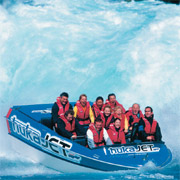Whakatane to Hawkes Bay - Day Two
Rotorua to Taupo

We welcome a slower start to the day, but I hurry Bob along somewhat as I have a special treat in store.
At 10 am we pull into the car park at Wai-O-Tapu, purchase tickets and join a small group seated at the Lady Knox geyser. “It only erupts once a day,” I say. We sit down to wait and after five minutes Bob’s beginning to fidget. After ten he strums his fingers on his knees. Finally he says: “We could be waiting all day.”
At 10.15 sharp a park ranger walks to the geyser and begins to tell her story. The Lady Knox was accidentally discovered in 1896 when prisoners washing their laundry were interrupted by a towering spray of water out of the ground. Now, every day at 10.15, the geyser is coaxed into action with Sunlight soap, much to the amazement of onlookers - including Bob, who waggles his finger at me as the hot soapy water spouts high.
After that, we take a walk through the park’s panoramic hot and cold pools, fumaroles and boiling mud, which display an amazing array of colours. For a time we sit beside the bubbling champagne pool with its impressive ochre-tinged edge.
Then we continue to Taupo and stop at the Prawn Farm in Wairakei Tourist Park, a geothermal- heated prawn farm where kiwi ingenuity is at its finest! Fresh water tropical prawns flourish here in recycled geothermal water from Wairakei Power Station. We take a short tour, then dine on freshly harvested prawns at its restaurant overlooking the Waikato River. NZ’s longest river, it begins its 425 kilometre journey to the sea from Lake Taupo where it pushes through a long narrow gorge before plunging over the Huka Falls. There are a number of good walks in the area but instead we opt for an exhilarating jetboat ride up to the base of the falls.
After collecting our car we visit the Taupo information centre which provides an exhaustive list of things to do: cruising on the lake to Maori rock carvings; taking a spin in a jet boat; parachuting; paraponting; playing golf; kayaking; sailing; windsurfing; fly fishing; bungy jumping; hiking and so the list goes on.
With so much on offer it almost seems sinful to relax, but relax we do, after first checking into our beachfront accommodation. Bob drags two deck chairs down onto Lake Taupo’s crisp pumice sands and here, against a stunning backdrop of snowy capped mountains in the Tongariro National Park, we watch everyone else’s energetic antics. Late in the day dinner comes courtesy of our hosts Tim and Jan, who on the spur of the moment decide to “throw the line in” from their runabout. Spotting us on the lakeshore they ask if we’d like to come along for the ride. Bob’s on board in a jiffy, getting soaked in the process such is his haste. I climb onboard too: rainbow and brown trout thrive in these parts and you’d be mad not to try your hand angling if given half a chance.
The boys throw the lines in and before long Bob’s rod bends tautly and the reel spins – it’s a strike! A beautiful rainbow trout leaps out of the water, bucking furiously. It puts on a good show, writhing two or three times before it tires and Bob gleefully pulls it aboard in the net.
“She’s a beauty,” says Tim, “A good seven pounds at least.” It’s a good fish alright, thick through the middle with a glossy coat. Bob’s delighted and after a quick grin at the camera, he carefully extracts the hook and slings his line back into the lake. “If I could catch trout like this at home I’d be a happy man,” he says.
Back on terra firma Tim carries the catch to a filleting table on the lake edge and we watch as he skilfully guts the fish. Its flesh is pink with an almost orange hue. Tim says this is unique to Lake Taupo as the fish feed on koura (native crayfish) which gives their flesh an apricot tone and an extra yummy almost salmon-like flavour.
While the trout smokes we enjoy a glass of wine or two (courtesy of Bob’s West Auckland wine-spending spree) and exchange fishy tales, then enjoy a meal of delectable smoked trout with fresh salad greens.